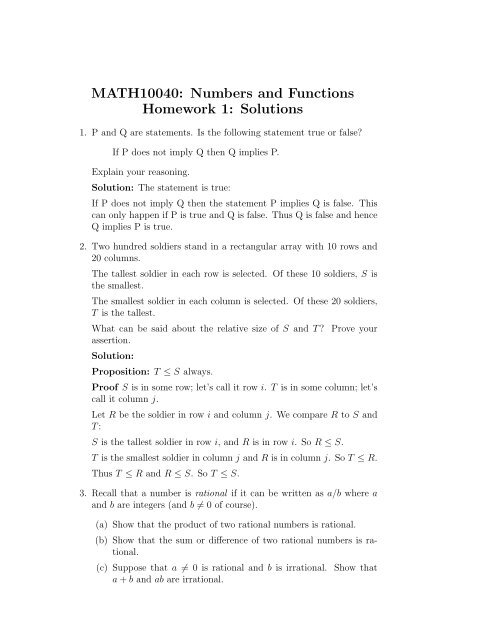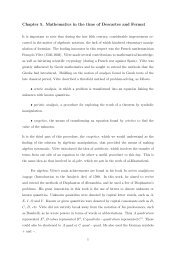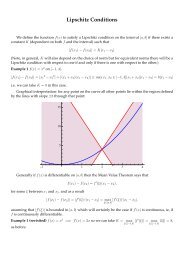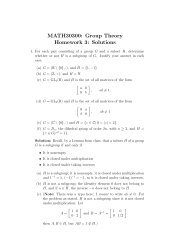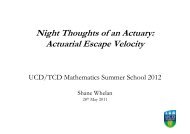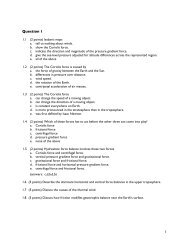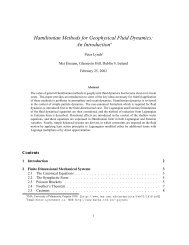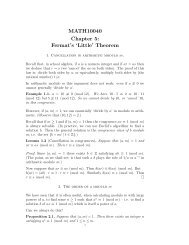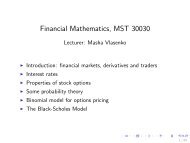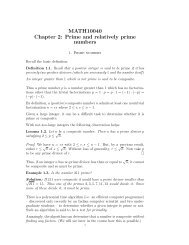MATH10040: Numbers and Functions Homework 1: Solutions
MATH10040: Numbers and Functions Homework 1: Solutions
MATH10040: Numbers and Functions Homework 1: Solutions
Create successful ePaper yourself
Turn your PDF publications into a flip-book with our unique Google optimized e-Paper software.
<strong>MATH10040</strong>: <strong>Numbers</strong> <strong>and</strong> <strong>Functions</strong><strong>Homework</strong> 1: <strong>Solutions</strong>1. P <strong>and</strong> Q are statements. Is the following statement true or false?If P does not imply Q then Q implies P.Explain your reasoning.Solution: The statement is true:If P does not imply Q then the statement P implies Q is false. Thiscan only happen if P is true <strong>and</strong> Q is false. Thus Q is false <strong>and</strong> henceQ implies P is true.2. Two hundred soldiers st<strong>and</strong> in a rectangular array with 10 rows <strong>and</strong>20 columns.The tallest soldier in each row is selected. Of these 10 soldiers, S isthe smallest.The smallest soldier in each column is selected. Of these 20 soldiers,T is the tallest.What can be said about the relative size of S <strong>and</strong> T ? Prove yourassertion.Solution:Proposition: T ≤ S always.Proof S is in some row; let’s call it row i. T is in some column; let’scall it column j.Let R be the soldier in row i <strong>and</strong> column j. We compare R to S <strong>and</strong>T :S is the tallest soldier in row i, <strong>and</strong> R is in row i. So R ≤ S.T is the smallest soldier in column j <strong>and</strong> R is in column j. So T ≤ R.Thus T ≤ R <strong>and</strong> R ≤ S. So T ≤ S.3. Recall that a number is rational if it can be written as a/b where a<strong>and</strong> b are integers (<strong>and</strong> b ≠ 0 of course).(a) Show that the product of two rational numbers is rational.(b) Show that the sum or difference of two rational numbers is rational.(c) Suppose that a ≠ 0 is rational <strong>and</strong> b is irrational. Show thata + b <strong>and</strong> ab are irrational.
Solution:(a) Let p, q be rational numbers. So there are integers a, b, c, d suchthat p = a/b <strong>and</strong> q = c/d. Thereforepq = a b · cd = acbdwhich is a rational number since ac, bd ∈ Z.(b) Again, let p = a/b <strong>and</strong> q = c/d where a, b, c, d ∈ Z (<strong>and</strong> b, d ≠ 0).Thenp ± q = a b ± c d = adbd ± bc ad ± bc=bd bdis rational since bd, ad ± bc ∈ Z.(c) Let c = a + b, d = ab.Suppose, FTSOC, that c is rational. Since a is rational, it followsfrom (b) that c − a = b is rational: a contradiction. So c isirrational.Similarly, suppose FTSOC that d is rational. Now a ≠ 0 isrational, hence 1/a is rational. By (b), it follows that (1/a)·d = bis rational: again, a contradiction.4. We will show later that √ 2 is an irrational number. Give an exampleof two distinct positive irrational numbers a <strong>and</strong> b which have theproperty that a + b is rational. Prove your assertions.Solution: Take a = √ 2 <strong>and</strong> b = 2 − √ 2.First we show that b is irrational: √ 2 is irrational, hence so is − √ 2.Since 2 is rational, b = 2 + (− √ 2) is irrational by part (c) of the lastexercise.Note that b > 0 since 2 > √ 2. Also b ≠ a.(Proof: b = a =⇒ √ 2 + √ 2 = 2 =⇒ 2 √ 2 = 2 =⇒ √ 2 = 1, acontradiction.)So a, b are distinct postive irrational numbers whose sum is 2.5. Prove by induction on n that for all natural numbers n ≥ 11 2 + 2 2 + · · · + n 2 =n(n + 1)(2n + 1).6Solution: For n = 1 the statement reads<strong>and</strong> so is true.1 2 =1 · 2 · (2 + 1)6= 6 6 = 1
Suppose we have proved the statement for some n. Then1 2 + · · · + n 2 + (n + 1) 2 n(n + 1)(2n + 1)= + (n + 1) 2 (by our inductive hyp.)[ ]6[ ]n(2n + 1)2n 2 + 7n + 6= (n + 1) ·+ n + 1 = (n + 1) ·66(2n + 3)(n + 2)= (n + 1) ·6which is precisely the statement for n + 1.So we’re done, by induction.6. Suppose that x is a number other than 1. Prove by induction on nthat for all natural numbers n ≥ 11 + x + x 2 + · · · + x n = xn+1 − 1x − 1 .Solution: For n = 1, the statement readswhich is clearly true.1 + x = x2 − 1x − 1 = 1 + xSuppose that we have proved the statement for some n.Then1 + x + · · · + x n + x n+1 = xn+1 − 1x − 1= xn+1 − 1 + x n+1 (x − 1)x − 1which is the statement for n + 1.7. Prove by induction on n that(1 − 1 4for all integers n ≥ 2.) (1 − 1 9Solution: When n = 2 the statement is+ x n+1 (by our inductive hyp.)= xn+1 − 1 + x n+2 − x n+1x − 1= xn+2 − 1x − 1)· · ·(1 − 1 )= n + 1n 2 2n1 − 1 4 = 3 4
which is visibly true.Suppose the statement is true for n. Then(1 − 1 )· · ·(1 − 1 ) ()1· 1 −4 n 2 (n + 1) 2= n + 12nwhich is the statement for n + 1.(1 −= n + 12n ·(n + 1) 2 − 1= (n + 1)2 − 1(n + 1) 2 2n(n + 1)= n2 + 2n2n(n + 1)=n + 22(n + 1))1(n + 1) 28. Let p 1 = 2, p 2 = 3, p 3 = 5, p 4 = 7, . . . be the sequence of primes.What is p 13 ? Prove that p n ≥ 2n + 15 for all n ≥ 13.Solution: We prove the statement by induction on n ≥ 13.p 13 = 41 = 2 · 13 + 15. So the statement is true for 13.Suppose now that the statement is true for some n ≥ 13. Thenp n+1 ≥ p n + 2 (why?) <strong>and</strong> p n ≥ 2n + 15 by our inductive hypothesis.Thus p n+1 ≥ (2n + 15) + 2 = 2(n + 1) + 15 as required.9. Explain carefully what is wrong with following argument:Proposition Everybody has the same number of hairs.Proof: We’ll prove this by induction on n, the number of people.If n = 0 or 1, the statement is clearly true.Assume the statement is true for any n people, <strong>and</strong> suppose there isa group of n + 1 people. Remove one person from the group. By ourinductive hypothesis, the remaining n all have the same number ofhairs. Remove a different person. The remaining n people all havethe same number of hairs. Therefore the first person has the samenumber of hairs as all the rest, <strong>and</strong> hence all n + 1 have the samenumber of hairs.Solution: The inductive step in the argument as given fails whenn = 1: In this case n + 1 = 2 <strong>and</strong> when we remove a ‘different person’only the first person remains <strong>and</strong> there is no ‘all the rest’.10. Prove or disprove the following statement: For all natural numbers n,n 2 − n + 41 is a prime number.Solution: The statement is false: taking n = 41, 41 2 − 41 + 41 = 41 2is not prime (it has factors 1, 41 <strong>and</strong> 41 2 ).(by our inductive hyp.)


